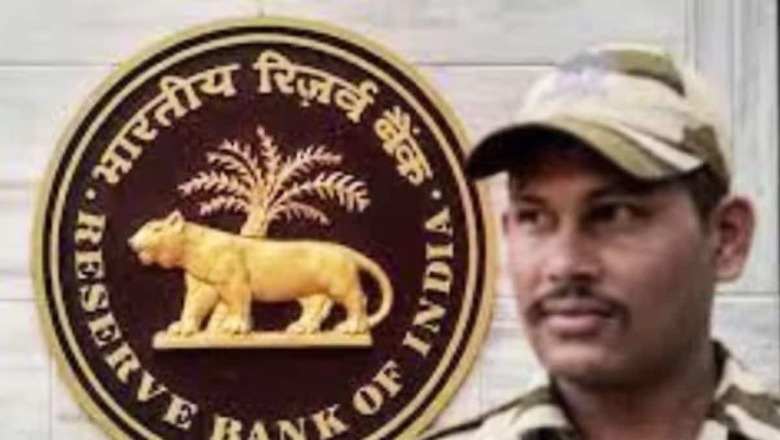
views
After keeping the repo rate unchanged for seven times in a row, there have been expectations of the RBI MPC to start cutting interest rates soon, though the timing is not known. The upcoming RBI’s monetary policy committee meeting, between June 5 and June 7, is going to announce its decision on June 7. Analysts expect the monetary policy to remain unchanged this time also.
Suman Chowdhury, chief economist and head (research) at Acuité Ratings & Research, said, “CPI inflation for April 2024 remained largely unchanged at 4.83 per cent vis-à-vis 4.85 per cent in March 2024, highlighting the resistance it faces in reaching near the RBI MPC target of 4 per cent. Sequentially, the headline inflation print rose by 0.48 per cent largely and expectedly driven by food inflation in the summer season.”
The annualised food inflation moved further northward to 8.7 per cent in April 2024 with a sequential rise of 0.7 per cent. Fruits saw a sharp MoM climb by 6.2 per cent, the highest among the food categories. Vegetables rose by 1.3 per cent MoM, reflecting the reduced availability during the intense summer months, he added.
However, the comfort emerges from the Core CPI inflation (excluding all food and fuel components) which remained virtually stagnant at 3.4% in April 2024, Chowdhury said.
“We expect RBI to maintain the status quo on the monetary policy till October 2024,” he added.
In the previous monetary policy, the RBI MPC kept the repo rate unchanged for the seventh time in a row, at 6.5 per cent. The monetary policy stance continues to be ‘withdrawal of accommodation’. The repo rate unchange decision has been taken with 5 members in favour of the decision out of the total 6.
Aditi Nayar, chief economist and head (research and outreach) at ICRA, said, “The headline CPI inflation print dipped marginally to an 11-month low of 4.8 per cent in April 2024 from 4.9 per cent in March 2024, while printing in line with ICRA’s projection. The moderation was led by a larger deflation in the fuel and light segment, and softer prints for the clothing and footwear, and pan, tobacco and intoxicants groups.”
Inflation in the food and beverages group inched up to 7.9 per cent in April 2024 from 7.7 per cent in March 2024, although this was not broad-based, and was led by higher prints across just four of the 12 sub-groups, namely cereals, meat and fish, oils and fats, and fruits. Inflation in the vegetables and pulses categories remained in double-digits for the sixth and eleventh consecutive month, respectively, thereby contributing to the elevated food and beverages print. Notably, inflation in spices eased to single digits in April 2024 after a gap of 22 months, she said.
Although the YoY inflation in the miscellaneous segment remained unchanged at 3.5 per cent in April 2024 vis-à-vis the previous month, the MoM uptick was larger than expected at 0.6 per cent, marking the highest increase in as many as 23 months.
This can largely be attributed to an unusually high 3.0% sequential increase in the personal care and effects sub-group, possibly reflecting the surge in global gold prices.
“ICRA fears that the food and beverages inflation will retrace above the 8 per cent mark in May 2024, partly on account of the adverse base (+3.3 per cent in May 2023 vs +4.2 per cent in Apr 2023), as well as the above-normal temperatures and heatwave conditions during the summer season, which would push up the headline CPI inflation to a five-month high of 5.1-5.2 per cent in the ongoing month,” Nayar added.
The impending favourable base effects during Q2 FY2025 are expected to materially soften the headline inflation print to 2.0-4.0% in July 2024 and August 2024. Nevertheless, a timely onset and well distribution of monsoon season would be crucial to support agriculture output in 2024-25 and help control food inflation.
“With continued uncertainty, especially on the risks to the food inflation trajectory after Q2 FY2025, the chance of a stance change in the upcoming June 2024 monetary policy review appears rather dim,” she said.
The rate increase cycle was paused in April last year after six consecutive rate hikes aggregating to 250 basis points since May 2022. The RBI last hiked the repo rate to 6.5 per cent in February 2023.
On the growth front, according to the latest official data, India’s gross domestic product (GDP) grew 7.8 per cent y-o-y during the January-March 2024 quarter (Q4 FY24) as compared with the 6.2 per cent growth recorded a year ago. It has surpassed analysts’ estimates.
For the full financial year 2023-24, India’s GDP growth rate stood at 8.2 per cent as against 7 per cent in FY23, according to an official statement.
“While these strong growth figures may present a challenge for the Reserve Bank of India (RBI) in its monetary policy decisions, slower inflation and ongoing fiscal consolidation should pave the way for modest rate reductions in the first half of 2025. This emerging scenario bodes well for the Indian equity market. Despite a sharp rally over the past 12 months, we expect equity returns to remain healthy in the next year,” said Sujan Hajra, chief economist and executive director, Anand Rathi Shares and Stock Brokers.




















Comments
0 comment